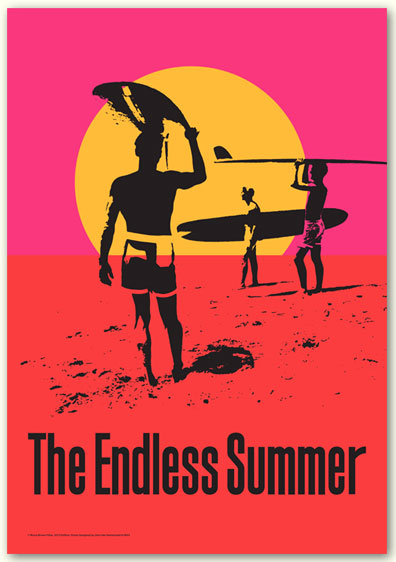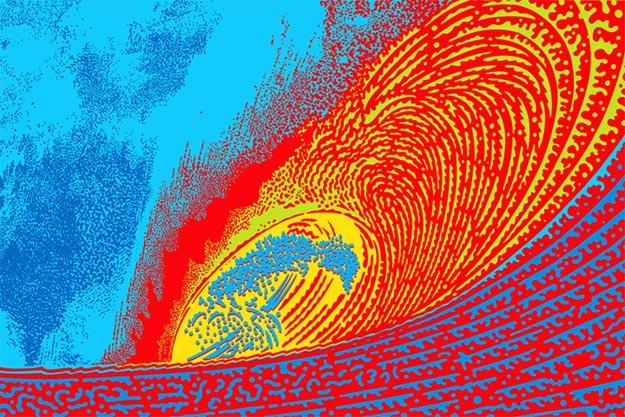John Van Hamersveld
Interview by Glenn Sakamoto





John Van Hamersveld designed the poster for the 1966 surfing movie “Endless Summer” from his kitchen table in Dana Point, California 50 years ago. It has gone on to become an internationally recognized icon of Southern California’s surfing scene.
What was it like growing up in the South Bay?
At 14 years old I grew up with two older boys, one was Phil Becker (a famous surfboard shaper) and the other is Jared Eaton (brother of Mike Eaton, Eaton Surfboards). They would take me on surfing trips to the Palos Verdes Cove to surf, with adventures to the Portuguese Bend club by bicycle to swim in the pool in 1955.
It was all about a simple lifestyle scene between the rich kids and poor kids in Palos Verdes and the beach cities at the ocean’s edge. I drove a Volkswagen in high school with surf racks. Brands of surfboards changed 18 times from 1954 to 1964. Surfers at the time seemed as if they were the “Mysto-Man,” different, distant – a non-conformist and seen as a beat by most. The only problem with the beach cities was you had to go somewhere else where the waves were big like Trestles, La Jolla, Malibu, or Rincon.
When did you get your first surfboard?
My first surfboard was from Dale Velzy. He transformed the old into the new modern surfboard and formed a label called Velzy & Jacobs Surfboards. When I was 17 years old, I met Bing Copeland and rode his surfboards. He made a great shape for beach surf in the South Bay.
What was the feeling you had when you first stood on a surfboard?
It was tricky at first. It was the balance – this surfing thing wasn’t easy. From the ocean side of the world, it took about a year and a half to get into the inertia and flow of the wave and what you could, or couldn’t control.
Who did you look up to and admire when you were a young man?
Velzy was like an instant father figure to all the kids at the time. I met Lance Carson in the Malibu scene. His father and my father worked at Northrop Aviation in Hawthorne on the early Fighting Wing Airplane project together. After meeting Lance, came Kemp Aaberg and others. They lived in the Pacific Palisades – that was so much like Palos Verdes. Malibu was where the better story started, like Gidget. The place was so ideal, where style was everything and surfers showed off their surf tricks. Each pose was like a trademark that each surfer had developed. Miki Dora was everything, the ultimate poser. He set the tone of the moves. It was just a perfect place – like a free beach club.
Where were you educated in art?
First came the art education from my talented mother, father, and grandfather. Then it was the Art Center School (now Art Center College of Design). I went on to Chouinard (renamed CalArts) and taught there for 7 years. I loved that scene. I was a part of it for 21 years as a student and as a professor-type.
What was working at Surfer Magazine like in the early days?
I was in Dana Point where I lived and worked at Surfer Magazine. I was still a student and a surfer at 22 years old. John Severson was a whole entity as a surfer. He was 7 years older than me. And Rick Griffin was 10 years younger.
The beginning of an industry grew out of the ‘50s with a new wave of modern surfers, riding on balsa, and then the foam surfboards. It started with Bob Simmons, Grubby Clark and Hobie Alter as they all made products for surfing. And then Hollywood and the media jumped in with their pseudo surf culture and that made it so plastic and confusing. The simple nature of early surfing and where the folklore had begun,all had become too complicated and expensive by the ‘60s.
The surf industry was supported by media. It’s movies and magazines grew into a three-headed monster and the crowds got too big. The beach club idea disappeared, leaving us sitting in it’s pollution. What does all of this mean? With the housing market exposed, everyone wanted a cheap house with a view of the ocean.
Explain how the iconic image for The Endless Summer came about?
The Endless Summer poster was designed in my night class at the Art Center, between my job at Surfer Magazine, on my kitchen table with services I could find in Santa Ana. Combined with my skill in drawing and rendering typography, I crafted my paste-up mechanical for silkscreening. This was one of the first posters in day-glo ink for the era – all printed in a local garage.
Who was your favorite musical act/personality you’ve gotten to work with?
Early Jagger… and the Exile album! Dylan… Pat Garret and the Billy The Kid album (that’s the song Knockin’ on Heavens Door). Most of my contacts were with managers and producers, not record label art directors – they did everything themselves. It was like being a wolf living in the woods. You could meet the talent in the woods before they went to town to drink in the saloon with the gamblers!
Who/what inspires you?
My mother showed me an Art In America Magazine with an article on Milton Glaser and Seymour Chwast and their newly created Push Pin Studio when I was 13 years old. I went to the Art Center School at 19 years old, and designed the “The Endless Summer Poster” at 22 years old. It was a hit then and now. That was inspiring.
What is the greatest thing you have learned in your life?
Psychology – learning about myself and the possibilities. One’s self is made up of all of your experiences and you don’t know them really – they just sit there, unknown to yourself. What psychology does is create insights as a part of the therapy to understand your potential. To “think outside the box” as an expression, like understanding change and how to cope with the changing world around you. Day by day, month after month and year after year – like who am I becoming?
Do you have any regrets or wish you had done something differently?
Hard to answer. But one regret is how fast time travels and you can’t do enough while time is passing so quickly. Like standing still one day as you watch the how fast the clouds move through the day to-night and that day is gone. Life is short.
What are you most proud of?
That I have lived and survived the Sixties and Seventies. Everyone entered the drugs, sex and rock n’ roll with their eyes wide open. Who would ever know all those times were so short-lived – with you or without you. I survived with a vision of the future! I really miss Rick Griffin as a drawing partner and as a friend.
What meaning does surfing hold for you and how has it changed your life?
The inertia that pushes the wave travels across the open sea to your local beach is amazing as a force. Also, understanding the momentum that pushes one while you stand and roll with the reaction to the changes. I marvel over the coördination of the sun, moon and the tide tables that define the perfect moment – where one can have time in both big and small surf. The surf is a system that you become one with while you live by the ocean.
What brings you the most happiness in the world?
The ironic!
Who are some of the people you feel are shaping the path for surfing today?
I’ve learned a lot about Shaun Tomson by drawing and designing the “Bustin Down The Door” movie from last year. All I see in the media is Kellly Slater. I have spent some time with Donavon Frankenreiter, who seems to have an interesting relationship of surf and rock.
What is in your current quiver? What is your favorite board?
None. But I lived in Malibu on my compound studio in Ramirez Canyon near Paradise Cove with a quiver of 15 surfboards, and some paddle boards too. I surfed for 12 years there and realized that it was all polluted. I got sick of the place with the rich and famous who had their head in the sky. And I would get sick and fall into confusion about why I was so sick so often. I stopped surfing in 1991, ending my career as a surfer. There is a different SUN now! And the ocean doesn’t have a government to take care of it.
Here is an example of how pollution works in Jamaica, and how the people living on the island hillsides look down at the ocean’s beaches. Pee and shit and all of “it” is a jungle that goes down the hill when it rains. The oceans are polluted off the edges of the beaches, until the tides take “it” somewhere.
What’s your favorite meal?
I’m always on a diet, so I am always surrounded in a world of carbs. So I have to keep everything simple.
What are you listening to on your iPod?
Buddha Lounge, Ahmad Jamal, Dylan, Van Morrison, and Leonard Cohen.
What’s next for JVH?
Everything one can think of doing.
More information about John Van Hamersveld can be found at www.johnvanhamersveld.com. He is currently finishing a coffee-table book of his life and art, “Post Future,” due in 2010.
